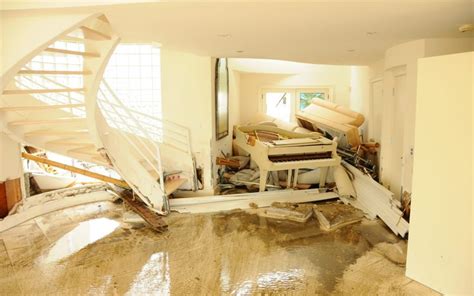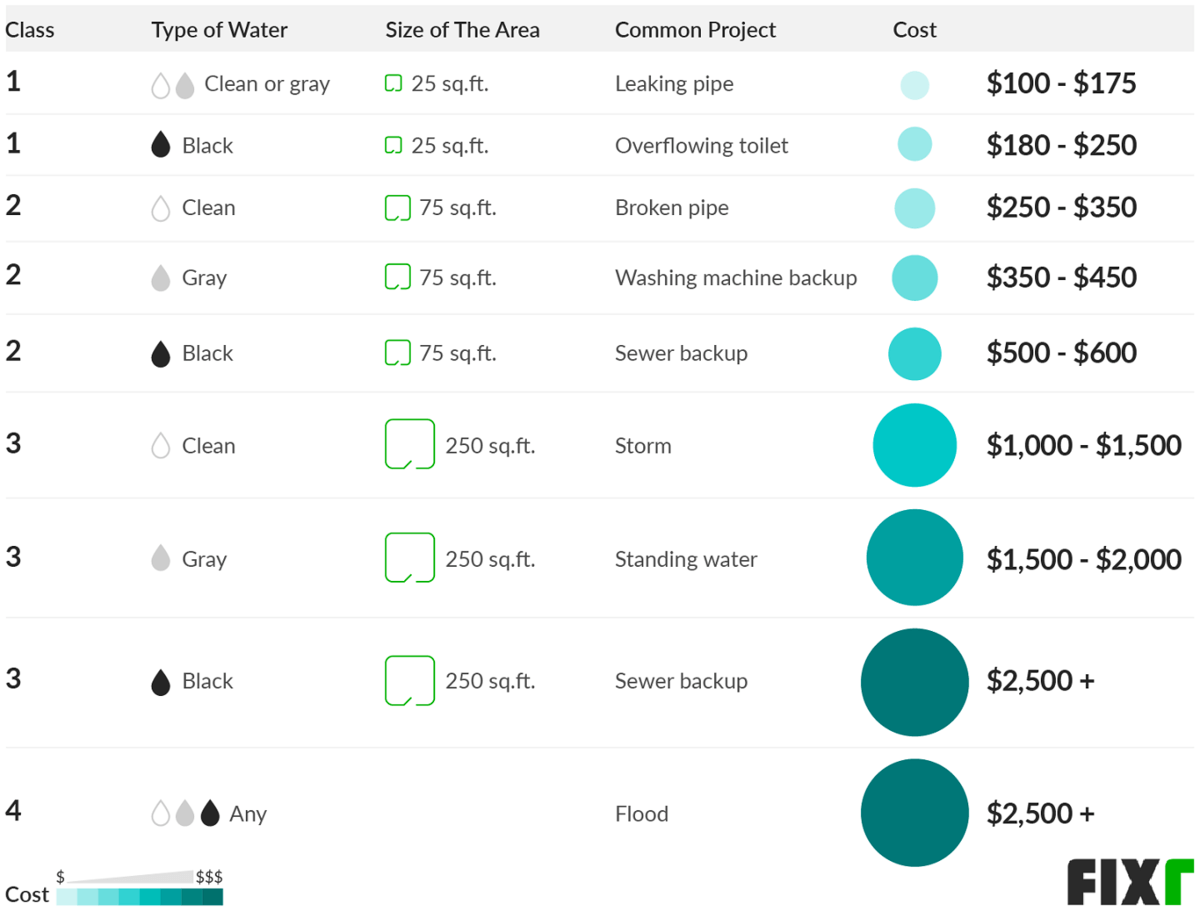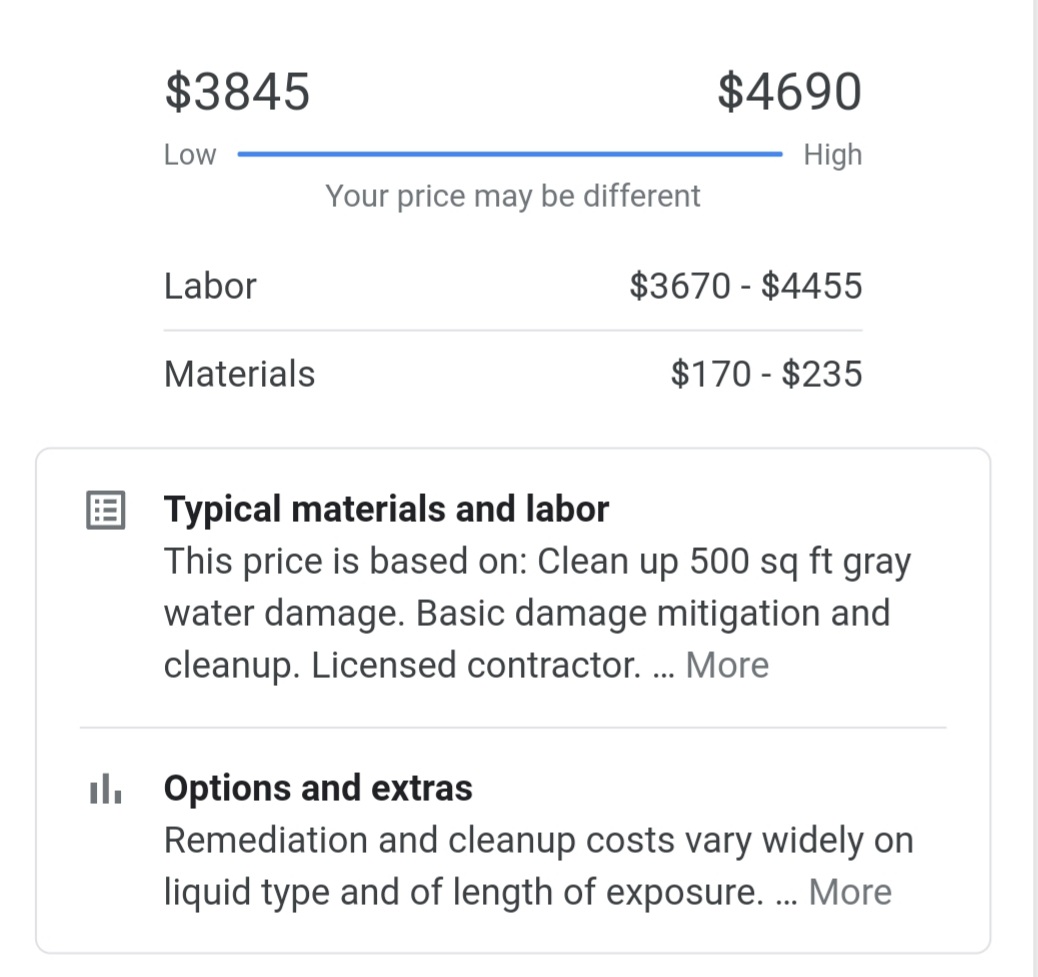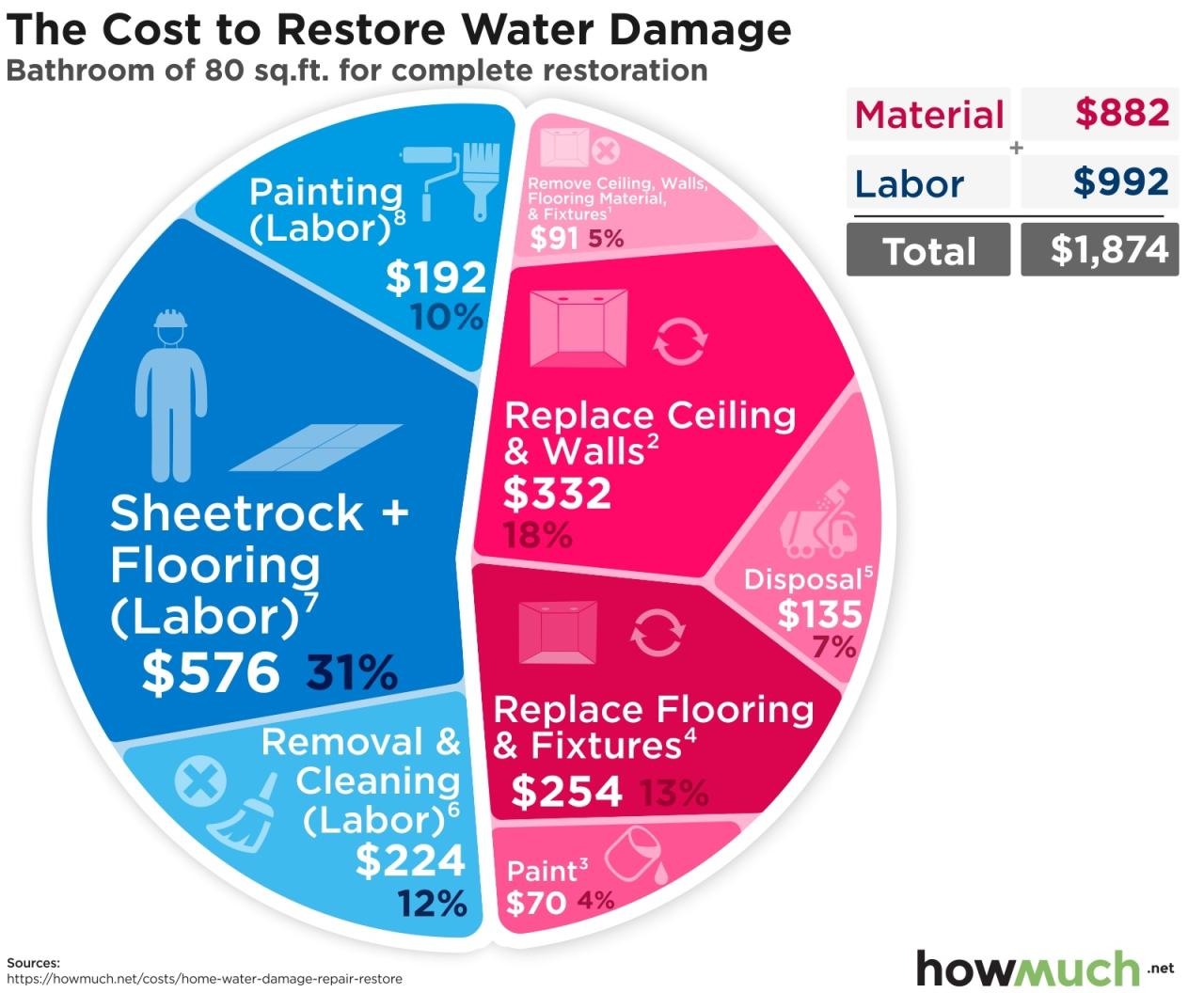Exploring the intricacies of flood damage restoration cost unveils a complex web of factors that influence pricing. From the extent of water damage to the presence of mold, every detail plays a crucial role in determining the overall cost. Let's delve into the world of flood damage restoration expenses and discover how various elements converge to shape the final bill.
 As we navigate through the breakdown of costs, explore cost-saving tips, and weigh the pros and cons of professional versus DIY restoration, a comprehensive understanding of flood damage restoration cost emerges, offering insights that can aid in decision-making and preparation for unforeseen circumstances.
As we navigate through the breakdown of costs, explore cost-saving tips, and weigh the pros and cons of professional versus DIY restoration, a comprehensive understanding of flood damage restoration cost emerges, offering insights that can aid in decision-making and preparation for unforeseen circumstances.
 When it comes to flood damage restoration, the costs can add up quickly. Let's break down the typical costs involved in the restoration process.
. Here are some cost-saving tips to help you navigate through this challenging situation:
When it comes to flood damage restoration, the costs can add up quickly. Let's break down the typical costs involved in the restoration process.
. Here are some cost-saving tips to help you navigate through this challenging situation:
 When it comes to dealing with flood damage restoration, one of the key decisions homeowners face is whether to hire professionals or attempt a do-it-yourself (DIY) approach. Each option has its own benefits and drawbacks, which should be carefully considered based on the specific circumstances of the damage.
When it comes to dealing with flood damage restoration, one of the key decisions homeowners face is whether to hire professionals or attempt a do-it-yourself (DIY) approach. Each option has its own benefits and drawbacks, which should be carefully considered based on the specific circumstances of the damage.
 In conclusion, the landscape of flood damage restoration cost is multifaceted, requiring a nuanced approach to navigate through the complexities effectively. By being informed about the factors at play, understanding cost breakdowns, implementing cost-saving strategies, and evaluating professional versus DIY options, individuals can better prepare for and manage the financial aspects of flood damage restoration.
In conclusion, the landscape of flood damage restoration cost is multifaceted, requiring a nuanced approach to navigate through the complexities effectively. By being informed about the factors at play, understanding cost breakdowns, implementing cost-saving strategies, and evaluating professional versus DIY options, individuals can better prepare for and manage the financial aspects of flood damage restoration.
 As we navigate through the breakdown of costs, explore cost-saving tips, and weigh the pros and cons of professional versus DIY restoration, a comprehensive understanding of flood damage restoration cost emerges, offering insights that can aid in decision-making and preparation for unforeseen circumstances.
As we navigate through the breakdown of costs, explore cost-saving tips, and weigh the pros and cons of professional versus DIY restoration, a comprehensive understanding of flood damage restoration cost emerges, offering insights that can aid in decision-making and preparation for unforeseen circumstances.
Factors influencing flood damage restoration cost
When it comes to flood damage restoration, several factors can influence the overall cost of the process. Understanding these factors is crucial for homeowners and businesses alike to anticipate and budget for restoration expenses effectively.Extent of Water Damage
The extent of water damage is a significant factor in determining the cost of restoration. Larger areas affected by flooding will require more extensive cleanup, drying, and repairs, leading to higher costs.Type of Water (Clean, Gray, Black)
The type of water involved in the flooding also plays a role in determining restoration costs. Clean water poses fewer health risks and is easier to clean up compared to black water, which may contain sewage or other contaminants that require specialized cleaning processes.Affected Materials
The materials affected by the flooding, such as carpets, drywall, insulation, and furniture, will impact the overall cost of restoration. The need for repair or replacement of these materials will add to the total expenses.Location
The location of the property affected by flooding can also influence restoration costs. Properties in remote or inaccessible areas may require additional resources and time to reach, leading to higher costs.Presence of Mold
If mold growth is detected after flooding, remediation efforts will need to be included in the restoration process. Mold removal can be a complex and costly procedure, adding to the overall cost of restoration.Structural Damage
Structural damage caused by flooding can significantly increase restoration costs. Repairs to the foundation, walls, and other structural components of the property can be expensive and time-consuming.Specialized Equipment
The need for specialized equipment, such as industrial-grade dehumidifiers, air scrubbers, and moisture meters, can also impact the cost of flood damage restoration. These tools are essential for thorough drying and cleanup, but they come at an additional cost.Average cost breakdown for flood damage restoration
 When it comes to flood damage restoration, the costs can add up quickly. Let's break down the typical costs involved in the restoration process.
When it comes to flood damage restoration, the costs can add up quickly. Let's break down the typical costs involved in the restoration process.
Water Extraction
Water extraction is one of the first steps in flood damage restoration. This process involves removing standing water from the affected area using specialized equipment such as pumps and wet vacuums. On average, water extraction can cost anywhere from $500 to $3,000, depending on the extent of the water damage.Drying
After water extraction, the affected area needs to be thoroughly dried to prevent mold and further damage. The cost of drying typically ranges from $1,000 to $2,500, depending on the size of the area and the equipment needed.Repairs
Once the area is dry, repairs can begin. This may include replacing drywall, flooring, insulation, or other damaged materials. The cost of repairs can vary greatly depending on the extent of the damage and the materials used, but it can range from $2,000 to $10,000 or more.Mold Remediation
If mold is present in the affected area, mold remediation will be necessary to remove and prevent its growth. The cost of mold remediation can range from $500 to $6,000, depending on the extent of the mold infestation.Replacing Damaged Materials
In some cases, damaged materials such as furniture, appliances, or personal belongings may need to be replaced. The cost of replacing these items can vary greatly depending on the quality and quantity of the items.Labor Costs, Equipment Rental, Permits, and Additional Services
Labor costs, equipment rental, permits, and any additional services required for flood damage restoration can also contribute significantly to the overall cost. Labor costs can range from $20 to $75 per hour per worker, equipment rental can cost anywhere from $100 to $500 per day, and permits and additional services can add several hundred to several thousand dollars to the total cost.Cost-saving tips for flood damage restoration
When dealing with flood damage restoration, it's essential to find ways to minimize costs without compromising the quality of the restoration processEarly Intervention
Acting quickly is crucial when it comes to flood damage restoration. The longer you wait, the greater the damage can become, leading to higher restoration costs. By addressing the issue promptly, you can prevent further damage and minimize the overall expenses involved in the restoration process.DIY Cleanup Tips
While some aspects of flood damage restoration require professional help, there are certain tasks you can handle on your own to save money. Simple cleanup tasks like removing water with a wet/dry vacuum, drying out affected areas, and disposing of damaged items can be done DIY style. Just make sure to prioritize safety and wear protective gear when dealing with flood-damaged areas.Working with Insurance Providers
Insurance coverage can significantly reduce the financial burden of flood damage restoration. Make sure to review your insurance policy to understand what is covered and what steps you need to take to file a claim. By working closely with your insurance provider and providing thorough documentation of the damage, you can maximize your coverage and minimize out-of-pocket expenses.By implementing these cost-saving tips, you can effectively manage the financial aspect of flood damage restoration and ensure a successful recovery process.Professional vs. DIY flood damage restoration
 When it comes to dealing with flood damage restoration, one of the key decisions homeowners face is whether to hire professionals or attempt a do-it-yourself (DIY) approach. Each option has its own benefits and drawbacks, which should be carefully considered based on the specific circumstances of the damage.
When it comes to dealing with flood damage restoration, one of the key decisions homeowners face is whether to hire professionals or attempt a do-it-yourself (DIY) approach. Each option has its own benefits and drawbacks, which should be carefully considered based on the specific circumstances of the damage.
Benefits and Drawbacks of Hiring Professionals
- Benefits:
- Professional expertise and experience in handling flood damage restoration.
- Access to specialized equipment and tools for efficient and effective restoration.
- Time-saving as professionals can complete the restoration process quickly.
- Potential cost savings in the long run due to thorough and proper restoration work.
- Drawbacks:
- Higher upfront costs compared to a DIY approach.
- Reliance on the availability of professional services, which may lead to delays in restoration.
- Lack of direct control over the restoration process.
- Potential for miscommunication or misunderstandings between homeowners and professionals.
Benefits and Drawbacks of DIY Flood Damage Restoration
- Benefits:
- Cost-effective for homeowners on a tight budget.
- Opportunity for homeowners to learn new skills and take control of the restoration process.
- Flexibility in scheduling and decision-making throughout the restoration project.
- Potential cost savings if the damage is minor and manageable.
- Drawbacks:
- Lack of professional expertise and knowledge in handling complex restoration tasks.
- Requirement to invest in or rent specialized equipment, which can add to the overall cost.
- Time-consuming as homeowners may need to dedicate significant hours to complete the restoration.
- Potential for errors or incomplete restoration work, leading to further damage or issues.
Scenarios for Hiring Professionals vs. DIY Approach
In situations where extensive flood damage has occurred, involving structural damage, mold growth, or contaminated water, hiring professionals is strongly recommended. Professionals have the skills, experience, and equipment to safely and effectively restore the property. However, for minor water damage that is isolated and manageable, homeowners with some DIY skills may be able to handle the restoration process themselves. It is essential to assess the extent of the damage and the risks involved before deciding on the best approach for flood damage restoration.Ending Remarks
 In conclusion, the landscape of flood damage restoration cost is multifaceted, requiring a nuanced approach to navigate through the complexities effectively. By being informed about the factors at play, understanding cost breakdowns, implementing cost-saving strategies, and evaluating professional versus DIY options, individuals can better prepare for and manage the financial aspects of flood damage restoration.
In conclusion, the landscape of flood damage restoration cost is multifaceted, requiring a nuanced approach to navigate through the complexities effectively. By being informed about the factors at play, understanding cost breakdowns, implementing cost-saving strategies, and evaluating professional versus DIY options, individuals can better prepare for and manage the financial aspects of flood damage restoration.












